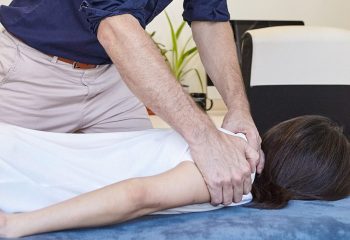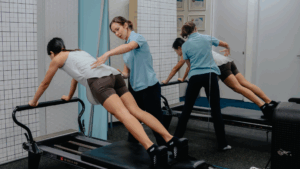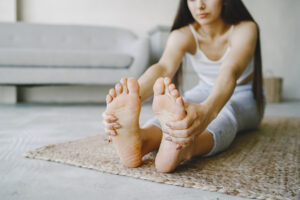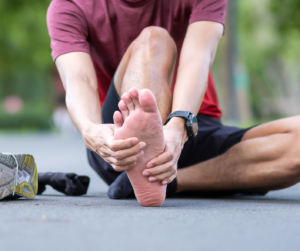Join us as we look into the intricate world of foot pain – an issue that plagues many but is often misunderstood. We’re here to unravel the mysteries surrounding foot discomfort, exploring its causes, various types, and effective relief methods. Let’s walk through the details together.
Foot pain charts
To accurately pinpoint these conditions, our practitioners utilise tools, such as comprehensive foot pain charts. These charts help them categorise pain based on its location, intensity, and accompanying symptoms. By cross-referencing a patient’s reported symptoms with the chart, our clinicians can identify the specific type of foot pain and address them accordingly.
Understanding the nuances of each foot pain type is crucial for developing precise and effective pain management plans. It allows practitioners to provide targeted relief, addressing the root causes and improving overall foot health.
If you’re experiencing any of these foot pains or other discomfort, our clinic is equipped with the tools and techniques necessary to help you on your journey to pain-free and healthy feet. Don’t let foot pain hold you back – take the first step towards relief and schedule a session with our practitioners today!
What are the types of foot pains?
Foot pain chart:

Feet, being intricate structures, can experience a diverse range of pains, each indicative of distinct underlying issues. Here’s an in-depth exploration of some common types of foot pains:
Plantar fasciitis
This condition involves inflammation of the plantar fascia, a thick band of tissue running across the bottom of the foot. Individuals with plantar fasciitis often experience stabbing pain near the heel as in the foot pain chart above, especially during the first steps in the morning.
Bunions
Bunions are bony protrusions that typically form at the base of the toes as seen in the foot pain chart. They can cause pain and discomfort, especially when wearing tight shoes, as they force the big toe and small toe to deviate inwards.
Osteoarthritis
Osteoarthritis, a wear-and-tear phenomenon, can affect the joints in the feet such as the ankle join as seen on the foot pain chart. This condition brings forth pain, stiffness, and a diminished range of motion, as the cartilage that cushions the joints wears away over time.
Rheumatoid arthritis
Rheumatoid arthritis, an autoimmune challenge, can target the joints in the feet. Beyond the typical pain and stiffness, this condition can lead to joint deformities at the toes area as seen in the foot pain chart, impacting the overall structure and function of the feet.
Nerve-related conditions like neuropathy
Peripheral neuropathy can result in tingling, numbness, or a burning sensation in the feet. Diabetes is a common cause of neuropathy, affecting the nerves and leading to sensory disturbances. Mostly, the affected area would be situated on the side of the foot, as seen in the foot pain chart.
Morton’s neuroma
Morton’s neuroma involves the thickening of tissue around the nerves leading to the toes, often causing a sharp, burning pain in the ball of the foot as seen in the foot pain chart. This condition is more prevalent between the third and fourth toes and can be aggravated by tight shoes.
Gout
Gout, a form of arthritis, can affect the feet, leading to sudden and severe pain, swelling, and redness, usually at the joint of the big toe as seen in the foot pain chart. It occurs due to the accumulation of urate crystals in the joints, often targeting the joint at the base of the big toe.
Achilles tendinitis
Achilles tendinitis involves inflammation of the Achilles tendon, causing pain along the back of the heel and lower calf as seen in the foot pain chart. It is often associated with overuse, improper footwear, or sudden increases in physical activity.
Stress fractures
Stress fractures are tiny cracks in the bones of the foot, often caused by repetitive impact or overuse. They can lead to localised pain, as seen in the foot pain chart, and are common in athletes or individuals engaged in high-impact activities.
Understanding these distinct foot pains is pivotal for effective management and relief. If you find yourself navigating the labyrinth of foot discomfort, our clinic is here to decipher the complexities and guide you towards a path of comfort and well-being. Step into a future where your feet carry you with ease and vitality.
What are the causes of foot pain?

When it comes to foot pain, a myriad of factors can contribute to the discomfort experienced by individuals. It’s not a one-size-fits-all situation; rather, the causes are diverse and often interconnected. Let’s delve deeper into the intricacies of what can lead to foot pain.
Improper footwear
Wearing shoes that don’t provide adequate support or are ill-fitting can be a major culprit in causing foot pain. High heels, shoes with narrow toe boxes, or those lacking proper arch support can lead to conditions like bunions, corns, and calluses. As illustrated in the foot pain chart, the strain from improper footwear can lead to conditions such as bunions or exacerbate existing problems like plantar fasciitis.
Injuries
Injuries, whether from a sudden trauma or repeated stress, can leave lasting imprints on our feet. Stress fractures, as depicted in the foot pain chart, are a result of repetitive impact or overuse, often seen in athletes or those engaging in high-impact activities. Accurate diagnosis and timely intervention are crucial in preventing lingering pain from injuries.
Underlying health conditions
The foot pain chart hints at the impact of health conditions on specific areas of the feet. Rheumatoid arthritis, gout, plantar fasciitis and neuropathy showcase how underlying health issues can manifest in distinct patterns. Recognising these connections is crucial for comprehensive foot pain management.
Wear and tear of daily activities
The foot pain chart serves as a visual guide to the wear and tear that accumulates over time. Continuous standing or walking on hard surfaces, especially in unsupportive footwear, can result in fatigue and pain. Osteoarthritis, a wear-and-tear phenomenon, affects joints as depicted in the pain chart, resulting in pain, stiffness, and reduced mobility.
Lifestyle choices
Our daily habits can significantly impact the health of our feet. Excessive standing, especially in occupations that demand it, can strain the muscles and contribute to discomfort. Improper walking techniques or gait abnormalities can also place undue stress on specific areas of the feet, leading to pain.
Our lifestyle choices can significantly impact our foot health. Prolonged standing, improper walking techniques, and high heels, can contribute to discomfort. Improper walking techniques or gait abnormalities can also place undue stress on specific areas of the feet, leading to pain as indicated din the foot pain chart. Recognising and modifying these habits is a pivotal step towards a pain-free stride.

Understanding the causes and foot pains, as depicted in our foot pain chart, empowers individuals to take proactive steps towards relief. Our experienced physiotherapists and osteopaths take a comprehensive approach, considering not only the symptoms but also the individual’s lifestyle, habits, and medical history. By piecing together this information, we can tailor a personalised plan that addresses the root cause of the pain, ensuring more effective and lasting relief for our patients. If you’re experiencing foot pain, don’t hesitate to reach out to our clinic for a thorough assessment and personalised care.
How to relieve foot pain?
When it comes to finding relief, we focus on addressing the root causes and enhancing overall foot health. Here are some methods that can complement and enhance the overall foot pain relief process:
Custom orthotics
Custom orthotic devices are specially designed insoles that provide additional support, cushioning, and alignment to the feet. As illustrated in our foot pain chart, by correcting imbalances in foot mechanics, orthotics can alleviate pain and discomfort caused by conditions such as plantar fasciitis.
Foot massage and reflexology
Regular foot massages can improve blood circulation, reduce tension, and promote relaxation. Reflexology, in particular, targets specific points on the feet believed to correspond to various organs and systems in the body. Aligning with our foot pain chart, this holistic approach can contribute to overall well-being and foot pain relief.
Strengthening exercises
In addition to physiotherapy, incorporating targeted strengthening exercises into your routine can enhance the stability and support of the feet. Toe-tapping, calf raises, and ankle circles are examples of exercises that can contribute to improved foot strength and function. As depicted in the foot pain chart, it can alleviate symptoms of osteoarthritis.
Physiotherapy

Physiotherapists employ tailored exercises, stretching routines, and manual therapy to enhance flexibility, strength, and circulation, aligned with the foot pain chart. This targeted approach aids in alleviating pain, promoting healing, and preventing future issues.
Osteopathy
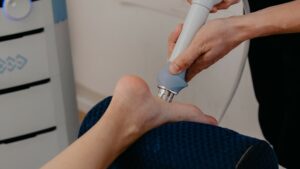
Osteopathic methods involve hands-on manipulation of the musculoskeletal system and usage of modalities to target imbalances and misalignments. Osteopathy aims to improve overall body function, offering relief from foot pain, as seen on the foot pain chart, by addressing interconnected issues throughout the body.
At our clinic, we understand that each individual may respond differently to various modalities. Our team of physiotherapists and osteopathists works collaboratively with patients to tailor a personalised plan that combines these diverse approaches, ensuring comprehensive and effective foot pain relief. If you’re seeking relief from foot pain, schedule a consultation with our practitioners to explore the best combination of therapies for your specific needs.
How does wearing proper footwear provide foot pain relief?
Choosing the right footwear is like providing a comfortable home for your feet. Ill-fitting shoes can contribute to a myriad of foot problems, from corns and calluses to more severe conditions like plantar fasciitis. Investing in proper footwear with adequate arch support, cushioning, and a comfortable fit can significantly reduce foot pain and prevent future issues.
Our practitioners can provide advice on selecting footwear tailored to individual needs, considering factors such as foot shape, gait, and specific foot conditions. This proactive approach ensures that our patients not only find relief from existing pain but also reduce the risk of recurrence.
What specific exercises are there to alleviate different types of foot pain?
Exercise can be a potent tool in managing and preventing foot pain. Tailored exercises can target specific muscle groups, improve flexibility, and alleviate strain on the feet. Here are some examples:
- Plantar fasciitis stretch: Gently stretching the plantar fascia can relieve tension and reduce pain.
- Toe tapping: Beneficial for improving circulation and relieving numbness associated with neuropathy.
- Calf raises: Strengthening the calf muscles can provide additional support to the feet, especially for those with flat feet.
Our clinic’s physiotherapists guide patients through personalised exercise routines, ensuring that the chosen exercises align with their specific foot condition and overall health goals.
A journey to foot pain relief
Foot pain is a multifaceted issue that deserves comprehensive attention. By understanding its causes, types as indicated in the foot pain chart, and effective relief methods, individuals can embark on a journey towards healthier and pain-free feet. If you’re experiencing foot pain, don’t hesitate to reach out to our clinic for personalised care and expert guidance. Walk comfortably, live pain-free!
FAQs
How can a foot pain chart help identify specific issues?
Foot pain charts are invaluable tools in our diagnostic arsenal. These charts categorise pain based on location, intensity, and accompanying symptoms. By correlating a patient’s reported pain with the chart, our practitioners can narrow down potential causes, leading to a more accurate diagnosis. This precision allows for targeted pain management plans, improving the likelihood of successful outcomes.
Are there effective home remedies for relieving foot pain?
While professional intervention is crucial for severe cases, several home remedies can complement pain management and provide relief. These include:
- Epsom salt soaks: Soaking feet in warm water with Epsom salts can reduce inflammation and ease soreness.
- Ice packs: Applying ice packs can alleviate swelling and numb pain.
- Foot massage: Gently massaging the feet improves blood circulation and provides relaxation.
However, it’s essential to consult with a professional to ensure that home remedies align with the specific foot condition and do not exacerbate the issue.
How does age influence the likelihood of experiencing foot pain?
Age can indeed influence the likelihood of experiencing foot pain. As we age, the wear and tear on our feet accumulate, and conditions such as arthritis become more prevalent. Additionally, changes in foot structure and reduced elasticity of connective tissues can contribute to discomfort.
Our practitioners’ approach takes into account the unique challenges that different age groups face. Whether it’s addressing age-related conditions or recommending preventive measures, we tailor our advice and management plans to suit the individual needs of our patients.


